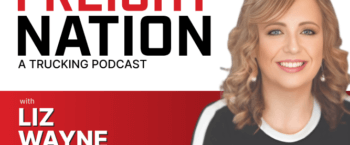Carrier Vetting: 7 Ways Brokers Can Verify Quality Carriers

Simplify carrier onboarding
Onboard compliant carriers right from your TMS.
As a broker, you probably already know how important it is to vet your carriers. You can be held liable if you hire a trucking company that is then involved in an incident while moving freight. When just starting out, you may not be sure of the best way to go about checking each carrier’s credentials or may end up spending your entire day tracking down their information. Fortunately, it is possible to ensure that your carriers are safe while being efficient with your time.
What is carrier vetting?
Carrier vetting is the process of checking carriers’ credentials, safety rating and compliance status. Manual checking is inefficient and time-consuming, and the information carriers provide may be inaccurate or outdated. With technology solutions, the best carrier vetting can happen within minutes.
Why carrier vetting is critical for brokers.
Carrier vetting for brokerages needs to be fast, reliable, and highly accurate. Not only are you at risk for liability if one of your carriers is involved in an incident, but there could be snowball effects that last much longer. Your reputation could take a hit, leading to business losses that could be tough to regain. Also, most shippers have carrier requirements. The vetting process helps to ensure that your carrier network fits your shippers’ needs.
The freight brokerage industry moves quickly. You need to be able to quickly hire and onboard new carriers to cover loads, keep shippers happy, and remain competitive. You also need to be able to trust the information you receive and to know that if anything changes, you will be proactively notified. Unfortunately, sometimes carriers present inaccurate or outdated documents. And they may not be inclined to share changes and updates, particularly in regards to safety incidents. A strong vetting system lets you go the extra mile for your shippers while providing the best protection against risk.
7 ways brokers should vet freight carriers.
Carrier vetting is an important part of the onboarding process. Fortunately for brokers, there are several options when it comes to quickly and accurately qualifying carriers. Here are seven ways that all brokers should vet freight carriers.
1. Check the RMIS carrier database.
Registry Monitoring Insurance Services (RMIS), now part of Truckstop’s compliance offering, which provides carrier onboarding and compliance monitoring services. Since the RMIS database covers nearly 98% of all North American carriers, this is a fast and easy way to vet and onboard carriers, as it reduces time to report back on this data from hours to minutes.
2. Check experience levels.
In the fast-paced world of freight, experience matters. An experienced carrier has the skills and knowledge to understand and adapt to rapidly changing market trends. Look for carriers who can show several years of experience in the business, as they are generally stable enough to withstand the financial ebbs and flows that are common in this industry.
3. Check on-time performance and reliability.
On-time delivery also matters when deciding which carriers you want to work with. It can be tough to find this information online, but most good carriers are willing to provide data on request. You can also talk to other companies that work with the carrier to get their opinions.
4. Check CSA percentile scores.
The Federal Motor Carrier Safety Administration (FMCSA) has a safety and compliance program known as CSA (compliance, safety, accountability). Their system, updated monthly, rates carriers on seven criteria:
- Unsafe driving
- Crashes
- Hours of service (HOS) compliance
- Maintenance
- Alcohol or drug use
- Hazardous materials compliance
- Driver fitness
Carriers are ranked from 0 to 100, with higher scores indicating more serious or more numerous violations. You can check the database to see different carriers’ scores and records.
5. Check carrier insurance certificates.

Freight carriers are required to hold various types of cargo insurance depending on their classification. You will need to obtain a valid insurance coverage certificate from each carrier you want to use and make sure that your certificates are kept up to date. Failure to do so could open you up to potential liability and compliance issues.
6. Check authority.
As a freight broker, you have broker authority issued through the FMCSA. Carriers are also required to obtain FMCSA authority as a Motor Carrier of Property. Make sure each carrier has valid authority, and, to avoid potentially sticky situations, avoid carriers that also have broker authority.
7. Check Watchdog reports.
Be sure to review the Transportation Intermediaries Association (TIA)’s Watchdog reports. Any member can report problems they experience with a particular company. After giving the company time to respond, TIA posts the complaint and any company response. Taking a look at these reports can help you see whether a particular carrier has a history of issues.
Speed up carrier onboading and compliance monitoring with automation tools.
The carrier vetting process can be complicated and time-consuming. Truckstop simplifies the process. We offer everything you need to access all the critical data and reports in a timely manner.
With the Carrier Onboarding, you can vet new carriers up to 80% faster than using manual processes, provide a customized carrier registration experience, and access 98% of today’s active carriers.
With the carrier selection checklists available in our Carrier Monitoring tool, you can set up your own selection criteria to rate carriers. The system will analyze all available data and automatically sort potential carriers into three buckets: acceptable, moderately acceptable, and unacceptable, based on your chosen criteria. You can even set up separate checklists for different shippers. Simply set your preferences and you can receive daily status updates as well as automated notifications of any changes. This can save you a great deal of time and effort when searching for new carriers or trying to determine if one of your existing carriers is a good match for a particular shipper.
Request a demo today of Truckstop Carrier Onboarding and Carrier Monitoring.
Simplify carrier onboarding
Onboard compliant carriers right from your TMS.

Find out how our platform gives you the visibility you need to get more done.
Get helpful content delivered to your inbox.
Schedule a demo.
Find out how our platform gives you the visibility you need to get more done.





